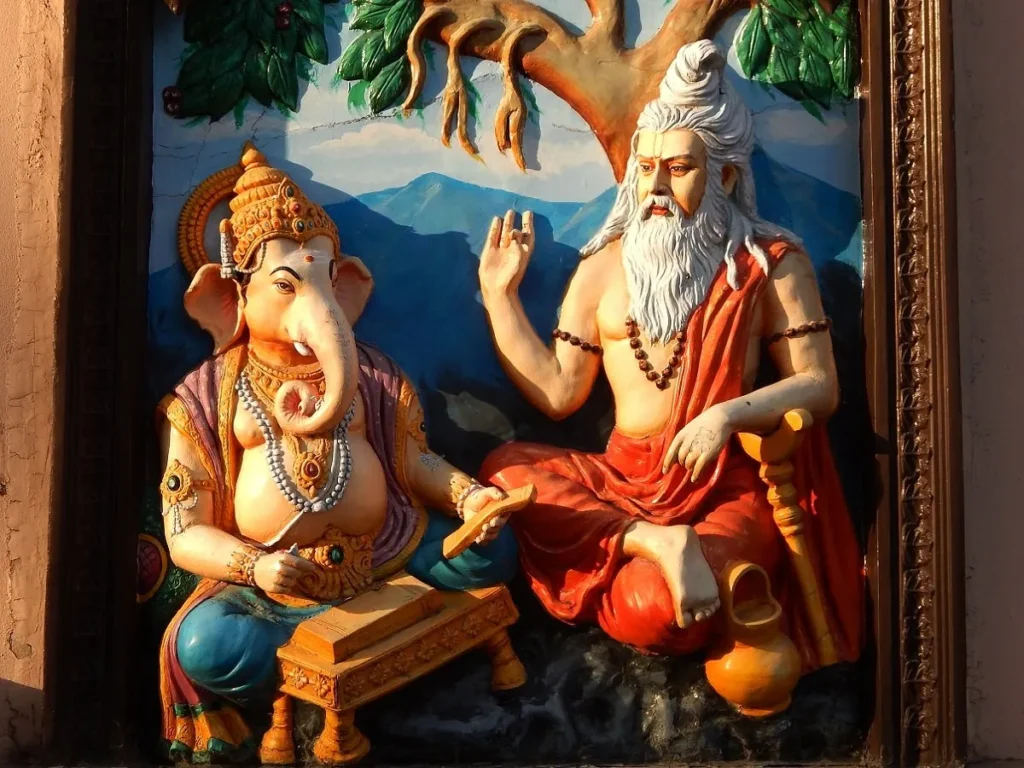
‘Listen, Oye ascetics, to the outlines of the several divisions (parvas)
of this history called Mahabharat, endued with great wisdom, of sections
and feet that are wonderful and various, of subtile meanings and logical
connections, and embellished with the substance of the Vedas.
‘The first parva is called Anukramanika ;
the second, Sangraha ;
then Paushya ;
then Pauloma ;
then Astika then Adivansavatarana.
Then comes the Sambhava of wonderful and thrilling incidents. Then
comes Jatugrihadaha (setting fire to the house of lac) and then Hidimba
badha ( the killing of Hidimba ) parvas ;
then comes Baka-badha
(slaughter of Baka) and then Chitraratha. The next is called Swayamvara
(selection of husband by Panchali), in which Arjuna by the exercise
of Kshatriya virtues, won Draupadi for wife. Then comes Vaivahiki
(marriage). Then comes Viduragamana (advent of Vidura), Bajyf
labha (acquirement of kingdom), Arjuna-banavasa (exile of Arjuna) and
Subhadra-harana (the carrying away of Subhadra). After these come
Harana-harika, Khandava-daha (the burning of the Khandava forest)
and Maya-darsana (meeting with Maya the Asura architect). Then
come Sabha, Mantra, Jarasandha, Digvijaya (general campaign). After
Digvijaya come Raja-syuaka, Arghyaviharana (the robbing of the Arghya)
andSisupala-badha(the killing of Sisupala). After these, Dyuta (gambling),
Anudyuta (subsequent to gambling), Aranyaka, and Krimira-badha
(destruction of Krimira). Then Arjunavigamana (the travels of Arjuna),
Kairati. In the last hath been described the battle between Arjuna
and Mahadeva in the guise of a hunter. After this Indra-lokavigamana
(the journey to the regions of Indra) ;
then that mine of religion and
virtue, the highly pathetic Nalopakhyana (the story of Nala). After
this last, Tirthayatra or the pilgrimage of the wise prince of the Kurus,
the death of Jatasura, and the battle of the Yakshas. Then the battle
20
MAHABHARATA
with the Nivata-kavachas, Ajagara, and Markandeya-Samasya (meeting
with Markandeya). Then the meeting of Draupadi and Satyabhama,
Ghoshayatra, Mriga-Swapna (dream of the deer). Then the story of
Brihadaranyaka and then Aindradrumna. Then Draupadi-harana (the
abductionof Draupadi), Jayadratha-bimoksana (the releaseof Jayadratha).
Then the story of ‘Savitri’ illustrating the great merit of connubial
chastity. After this last, the story of ‘Rama. The parva that comes next is called ‘Kundala-harana’ (the theft of the ear-rings). That which comes next is ‘Aranya and then ‘Vairata’. Then the entry of the
Pandavas and the fulfilment of their promise (of living unknown for one
year). Then the destruction of the ‘Kichakas1
,
then the attempt to
take the kine (of Virata by the Kauravas). The next is called the
marriage of Abhimanyu with the daughter of Virata. The next you
must know is the most wonderful parva called Udyoga. The next must
be known by the name of ‘Sanjaya-yana’ (the arrival of Sanjaya). Then
comes ‘Prajagara’ (the sleeplessness of Dhritarashtra owing to his
anxiety). Then Sanatsujata, in which are the mysteries of spiritual
philosophy. Then ‘Yanasaddhi’, and then the arrival of Krishna. Then
the story of ‘Matali’ and then of ‘Galava’. Then the stories of ‘Savitri’,
‘Vamadeva’, and ‘Vainya’. Then the story of ‘Jamadagnya and Shodasa
rajika*. Then the arrival of Krishna at the court, and then Bidulapu
trasasana. Then the muster of troops and the story of Sheta. Then,
must you know, comes the quarrel of the high-souled Kama. Then
the march to the field of the troops of both sides. The next hath been
called numbering the Rathis and Atirathas. Then comes the arrival
of the messenger Uluka which kindled the wrath (of the Pandavas).
The next that comes, you must know, is the story of Amba. Then
comes the thrilling story of the installation of Bhishma as commander
in-chief. The next is called the creation of the insular region Jambu ;
then Bhumi ;
then the account about the formation of islands. Then
comes the ‘Bhagavat-gita’ ;
and then the death of Bhishma. Then the
installation of Drona ;
then the destruction of the ‘Sansaptakas’. Then
the death of Abhimanyu ;
and then the vow of Arjuna (to slay
Jayadratha). Then the death of Jayadratha, and then of Ghatotkacha.
Then, must you know, comes the story of the death of Drona of surpri
sing interest. The next that comes is called the discharge of the weapon
called Narayana. Then, you know, is Kama, and then Salya. Then
comes the immersion in the lake, and then the encounter (between
Bhima and Duryodhana) with clubs. Then comes Saraswata, and
then the descriptions of holy shrines, and then genealogies. Then comes
Sauptika describing incidents disgraceful (to the honour of the Kurus).
Then comes the Aisika’. of harrowing incidents. Then comes ADI PARVA 21 ‘Jalapradana oblations of water to the manes of the deceased, and then
the wailings of the women. The next must be known as ‘Sraddha*
describing the funeral rites performed for the slain Kauravas. Then
comes the destruction of the Rakshasa Charvaka who had assumed the
disguise of a Brahmana (for deceiving Yudhishthira). Then the corona
tion of the wise Yudhishthira. The next is called the ‘Grihapravibhaga.
Then comes ‘Santi’, then ‘Rajadharmanusasana’, then ‘Apaddharma’,
then ‘Mokshadharma’.
Those that follow are called respectively
‘Suka-prasna-abhigamana’, ‘Brahma-prasnanusana’, the origin of
‘Durvasa’, the disputations with Maya. The next is to be known as
‘Anusasanika’. Then the ascension of Bhishma to heaven. Then the
horse-sacrifice, which when read purgeth all sins away. The next must
be known as the ‘Anugita’ in which are words of spiritual philosophy.
Those that follow are called ‘Asramvasa’, ‘Puttradarshana’ (meeting
with the spirits of the deceased sons), and the arrival of Narada. The
next is called ‘Mausala* which abounds with terrible and cruel incidents.
Then comes ‘Mahaprasthanika’ and ascension to heaven. Then comes
the Purana which is called Khilvansa. In this last are contained
‘Vishnuparva’, Vishnu’s frolics and feats as a child, the destruction of
‘Kansa’, and lastly, the very wonderful’Bhavishyaparva’ (in which there
are prophecies regarding the future)